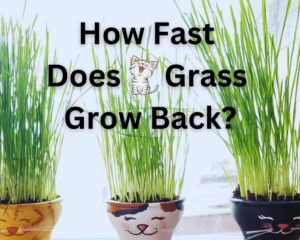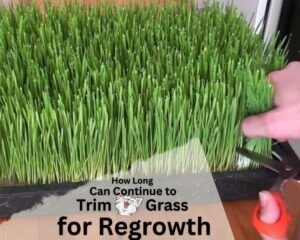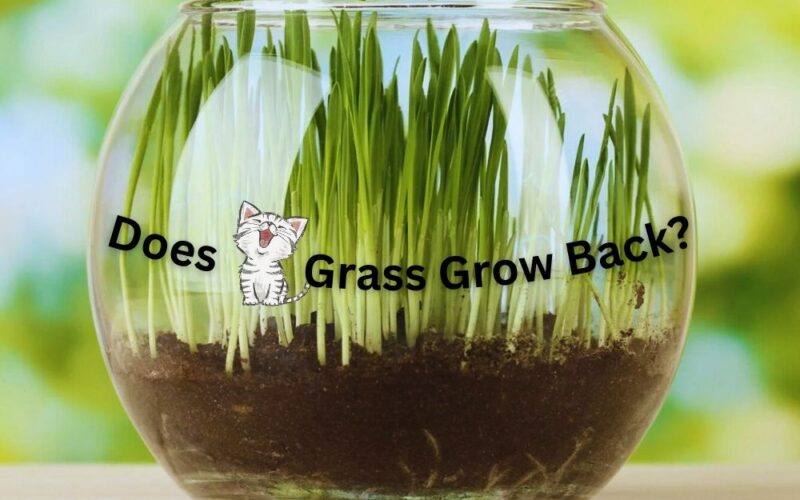In this article, I will answer one of the frequent questions about cat grass: Does Cat Grass Grow Back? Here, you will find all the things you must know about growing back cat grass and learn how to increase its lifespan by encouraging it to regrow. Keep reading!
The owners of cats try to enhance the welfare of their feline friends by adding cat grass to their living space! Cats like to nibble grasses due to its benefits from digestive enhancement to decreasing hairball formation. But after growing cat grass indoors, it will go to die after several weeks.
So, to provide fresh grass for your playful cat you must resow cat grass. But there is an easier way too: encourage cat grass to grow back. In this article, I want to discuss this issue in detail:
- First, I will tell you about the benefits of cat grass growing back.
- Secondly, I will show you how to do it.
- Third, I will discuss factors that have an impact on cat grass growing back
- Fourth, I will tell you how long you can continue this strategy.
- Fifth, you will find out how fast the cat grass will grow back.
- And finally, we will discuss cat grass growing back after repotting.
If you are ready, lets get going.
➡ You can listen to this article below.
Why You Must Encourage the Cat Grass to Grow Back?

Most people want to encourage cat grass to grow back due to having fresh grass for a long time, but there are other benefits to doing it for both your feline companion and your home environment. Before answering ” Does Cat Grass Grow Back?” let the first find its benefits.
- Continuous Supply of Fresh Greens: Regrowing cat grass ensures that your cat has access to fresh, healthy greens for a long time.
- New Nutritional Leaves: the nutritional value of new leaves is more than long old leaves. When cat grass grows back, it produces more new foliage.
- Air Purification: Indoor cat grass can help improve indoor air quality by acting as a natural air purifier. The grass can help absorb certain indoor pollutants and release oxygen. When cat grass grows back, produces more foliage and does it better.
- Cost-Efficient: growing back cat grass is cost-efficient compared to purchasing pre-grown cat grass pots. When your cat grass grows back, you can enjoy a steady supply of fresh cat grass at a lower cost.
- The easy way: encourage cat grass to grow back is easier than to resow it.
- Kid practice: if you let the kids help you trim cat grass, it will be enjoyable for them and can satisfy their needs for gardening.
Now you have found out the benefits of cat grass growing back, let to answer “Does Cat Grass Grow Back?” by showing you how to do it. keep reading.
How to Encourage Cat Grass to Grow Back?
The first step to answer “Does Cat Grass Grow Back?” is encouraging the cat grass to grow back. It is very easy, the only thing that you must do is trim your cat grass, just this! To do it well you should regularly trim the cat grass when it reaches a height of about 4-6 inches (10-15 cm).
Trimming encourages new growth and prevents the grass from becoming overly tall and leggy. How? there is a botanic hormone in the top of the leaves of grasses that we call Auxin, it is responsible for growing the leaf and causing the leaf to get longer and longer.
Another work of Auxin is inhabiting from producing new lateral leaves and stems. Hence, when you trim the cat grass, you allow it to produce more new foliage.
Although trimming is responsible for the regrowth of cat grass, it is not the only work that you must do to encourage the cat grass to grow back. The weak plant never can regrow even by trimming. I discuss the tips for taking care of cat grass in detail in my previous article, here I will review some of them:
Caring Point to Encourage Cat Grass to Grow Back
- Proper Watering: Consistent and appropriate watering is essential. Keep the soil consistently moist but not waterlogged. Watering as needed based on the moisture level of the soil will prevent the grass from drying out and promote regrowth.
- Sunlight: Cat grass requires adequate sunlight to grow. Place it in a sunny location where it can receive 4-6 hours of sunlight per day. If natural light is limited, consider using a grow light to supplement.
- Temperature: Maintain a suitable temperature for the specific cat grass variety you’re growing. Most cat grasses thrive in temperatures between 60°F and 75°F (15°C to 24°C). Avoid extreme cold or heat.
- Fertilization: While not always necessary, you can fertilize cat grass with a balanced, water-soluble fertilizer diluted to half strength every 2-4 weeks during the growing season. Follow the instructions on the fertilizer package.
- Well-Draining Soil: Ensure the potting soil has good drainage to prevent water from pooling around the roots, which can lead to root rot. Well-draining soil promotes healthy growth.
- Monitoring for Health: Regularly inspect the cat grass for any signs of mold, disease, or tiny bugs on your indoor plant. Address any issues promptly to maintain healthy growth. you can use natural ways such as Neem oil spray to control them.
The Important Factors That Have an Impact on Growing Back of Cat Grass

In the natural growth cycle of cat grass, after harvesting or trimming, the cat grass will respond by growing new blades from the base or remaining stems. This regrowth occurs because the roots and base of the grass plant are still intact and capable of producing new shoots. however, several factors have an impact on to answer “Does Cat Grass Grow Back?”
As you know, cat grass includes various grass species that are safe for cats. So, the type of seed you choose for cat grass can have the most impact on its regrowth ability. Different grass varieties have varying growth rates, resilience, and characteristics. I will consider their growth rate and regrowth potential in the next part. Keep reading!
How fast does cat grass grow back?
The speed at which cat grass grows back can vary depending on several factors, including the specific grass variety, growing conditions, and care practices. However, in general, cat grass, such as wheatgrass or oat grass, tends to grow back relatively quickly. Here, I will review the most common cat grass seed types and how they can affect regrowth
Wheatgrass (Triticum aestivum):
- Growth Rate: Wheatgrass is known for its rapid growth. It often sprouts and grows quickly, making it an excellent choice if you want a constant supply of fresh cat grass.
- Regrowth: Wheatgrass typically regrows well after trimming, allowing you to harvest and trim it multiple times.
Oat Grass (Avena sativa):
- Growth Rate: Oat grass also grows relatively quickly, providing a fresh supply of grass for your cat.
- Regrowth: Like wheatgrass, oat grass can regrow effectively after trimming, allowing for multiple harvests.
Barley Grass (Hordeum vulgare):
- Growth Rate: Barley grass tends to have a moderate growth rate. It may not grow as quickly as wheatgrass or oat grass.
- Regrowth: While barley grass can regrow after trimming, it may do so at a slightly slower rate compared to faster-growing varieties.

Rye Grass (Lolium perenne):
- Growth Rate: Rye grass is another option for cat grass, but it tends to grow more slowly than wheatgrass or oat grass.
- Regrowth: It can regrow after trimming, but you may need to be patient as it might take a bit longer to reach a suitable height again.
Catnip (Nepeta cataria):
- Growth Rate: Catnip is a different type of cat-friendly plant that some cats enjoy. It grows at a moderate pace.
- Regrowth: Catnip can also regrow after trimming, but it may have a slower regrowth rate compared to grass varieties.
So, wheatgrass and oat grass can be your popular choices due to their fast growth and regrowth capabilities, making them excellent options for encouraging multiple trimmings and a consistent source of cat grass.
How Long You Can Continue to Trim Cat Grass for Regrowth

After you find the answer “Does Cat Grass Grow Back?” now it is the turn of another critical question. Let to find the best answer to it. You can encourage your cat grass to grow back by trimming it multiple times throughout its lifespan. The lifespan of most cat grasses (wheatgrass, oat grass, and ryegrass) is around a few months. However, the catnip has a longer lifespan and can last for several months or even years.
However, caring points have an impact on this issue and you help you to continue to trim cat grass for regrowth. In general, After the initial trimming, you can continue to trim the cat grass whenever it reaches a similar height.
This may occur every 1-2 weeks (typically 2-4 times during its lifespan), depending on the growth rate of the specific grass variety and the growing conditions. While trimming, always monitor the health of the cat grass. If you notice any signs of stress or disease, or if the plant starts to look tired or yellowed, it’s a good idea to stop trimming and allow the grass to recover.
Does Cat Grass Grow Back After Repotting?
If you need to repot the cat grass and are concerned about its regrowth, I tell you not to worry, the cat grass can regrow after repotting, but it may experience a brief period of adjustment before it resumes vigorous growth. Here’s what you can expect after repotting cat grass:
- Initial Stress: Repotting can temporarily stress the cat grass plant as it adapts to its new environment and recovers from the disturbance to its roots and soil.
- Brief Slowdown: After repotting, you may notice a temporary slowdown in growth as the grass acclimates to the new pot and soil. During this time, it might focus on root development before putting energy into above-ground growth.
- Regrowth: Once the cat grass has settled into its new pot and established its roots, it should start to regrow. You can encourage this regrowth by providing proper care, including watering, adequate sunlight, and occasional trimming.
- Patience: It’s important to be patient during the post-repotting phase. Growth may not be as rapid immediately after repotting, but with time and consistent care, the grass should bounce back and begin to grow vigorously again.
- Maintain Care: Continue to care for the repotted cat grass as you normally would, and it should eventually regain its former health and lushness.
Conclusion
Thanks for continuing with us to the end of this article, now, you have an ultimate guideline for the regrowth of cat grass and can easily answer the first question: Does cat grass grow back? I provided you with details about the growth of this plant and gave you tips to encourage your cat grass to grow back.
Do you think which one of the cat grasses is more appropriate for your cat? I prefer wheatgrass due to its growing speed, how about you? please share your experiences and ideas with our readers and ask me if you have any questions on this issue.

Elahe Rabiei
Hi, I’m Elaheh. My Academic major is plant protection, and houseplants are my expertise. As a houseplant lover, my house is full of indoor plants and it is my passion to take care of them. Hence, I’m here to share my knowledge and experience about growing healthy houseplants. I am also a plant protection advisor, so feel free to ask me any questions you may have.

